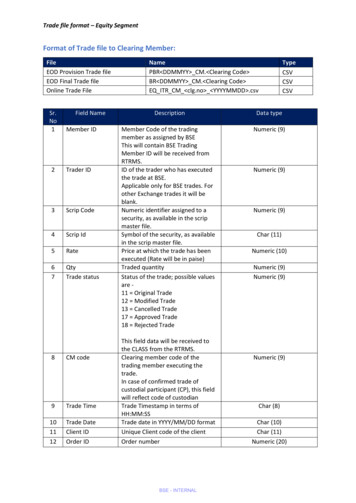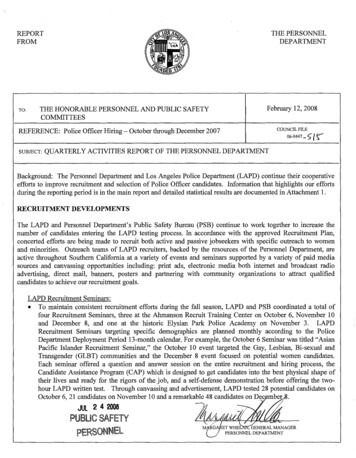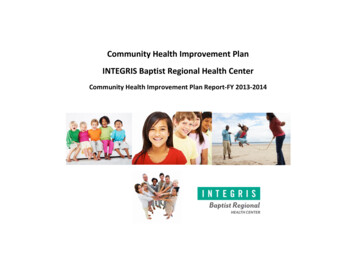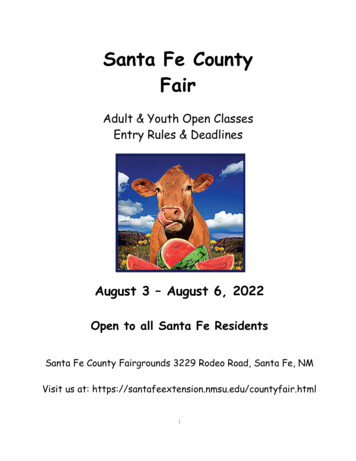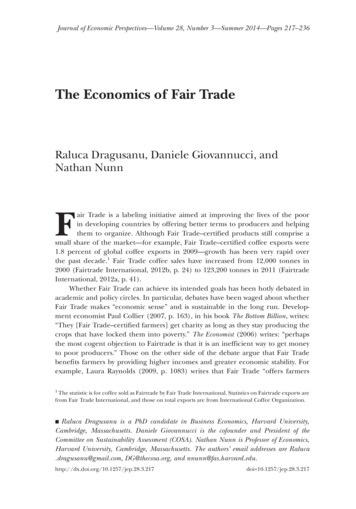
Transcription
Journal of Economic Perspectives—Volume 28, Number 3—Summer 2014—Pages 217–236The Economics of Fair TradeRaluca Dragusanu, Daniele Giovannucci, andNathan NunnFair Trade is a labeling initiative aimed at improving the lives of the poorin developing countries by offering better terms to producers and helpingthem to organize. Although Fair Trade–certified products still comprise asmall share of the market—for example, Fair Trade–certified coffee exports were1.8 percent of global coffee exports in 2009—growth has been very rapid overthe past decade.1 Fair Trade coffee sales have increased from 12,000 tonnes in2000 (Fairtrade International, 2012b, p. 24) to 123,200 tonnes in 2011 (FairtradeInternational, 2012a, p. 41).Whether Fair Trade can achieve its intended goals has been hotly debated inacademic and policy circles. In particular, debates have been waged about whetherFair Trade makes “economic sense” and is sustainable in the long run. Development economist Paul Collier (2007, p. 163), in his book The Bottom Billion, writes:“They [Fair Trade–certified farmers] get charity as long as they stay producing thecrops that have locked them into poverty.” The Economist (2006) writes: “perhapsthe most cogent objection to Fairtrade is that it is an inefficient way to get moneyto poor producers.” Those on the other side of the debate argue that Fair Tradebenefits farmers by providing higher incomes and greater economic stability. Forexample, Laura Raynolds (2009, p. 1083) writes that Fair Trade “offers farmers1The statistic is for coffee sold as Fairtrade by Fair Trade International. Statistics on Fairtrade exports arefrom Fair Trade International, and those on total exports are from International Coffee Organization. Raluca Dragusanu is a PhD candidate in Business Economics, Harvard University,Cambridge, Massachusetts. Daniele Giovannucci is the cofounder and President of theCommittee on Sustainability Assessment (COSA). Nathan Nunn is Professor of Economics,Harvard University, Cambridge, Massachusetts. The authors’ email addresses are Raluca.dragusanu@gmail.com, DG@thecosa.org, and p.28.3.217doi 10.1257/jep.28.3.217
218Journal of Economic Perspectivesand agricultural workers in the global South better prices, stable market links andresources for social and environmental projects” and that it “provides consumerswith product options that uphold high social and environmental standards.”The emergence of modern Fair Trade labels can be traced back to 1988, when afaith-based nongovernment organization from the Netherlands began an initiativethat aimed to ensure that growers of crops in low-income countries were provided“sufficient wages.” The organization created a fair trade label for their products. Itwas called Max Havelaar, after a fictional Dutch character who opposed the exploitation of coffee pickers in Dutch colonies. Over the next few years, the concept wasreplicated in other countries across Europe and North America, with a numberof organizations emerging, such as TransFair and Global Exchange. In 1997, thevarious national labeling initiatives formed an umbrella association called FairtradeInternational. A common Fair Trade Certification mark was launched in 2002 andthere are several Fair Trade bodies operating today.In 2012, Fairtrade International’s largest adherent, Transfair USA, split fromthe organization to launch a parallel label, Fair Trade USA. One of the primaryreasons for the division was the difference in beliefs about whether the Fair Tradelabel should only be available to small-scale producers. While Fairtrade Internationalbelieves that certification should generally be restricted to small producers, FairTrade USA feels that that large producers and plantations should also be certified.“Fairtrade,” the one-word form, is used by Fairtrade International for their certification mark and for references to their specific market. We use “Fair Trade” to referto the general initiative and movement without reference to a particular certification.Fair Trade attempts to achieve several goals; the primary and best-known is toprovide prices that deliver a basic livelihood for producers. In addition, Fair Tradehas a number of other goals, including longer-term buyer–seller relationships thatfacilitate greater access to financing for producers; improved working conditions;the creation and/or maintenance of effective producer or worker organizations;and the use of environmentally friendly production processes. A third-party certification process regularly checks that producers and suppliers adhere to a set ofrequirements whose purpose is to achieve these objectives. The Fair Trade labelthat is displayed on certified products is a signal to consumers that the product wasproduced and traded in accordance with these requirements.Fairtrade is one of the many voluntary sustainability standards that have emerged.These standards share some common overlapping goals but each has its own focusand priorities. In addition to Fair Trade, other certification standards includeOrganic, Rainforest Alliance, and UTZ Certified, and there are similarly prominentlabels for different products such as those of the Forest Stewardship Council, MarineStewardship Council, Roundtable on Sustainable Palm Oil, and Global G.A.P.22For information on Organic, see the website of the International Federation of Organic AgriculturalMovements at http://www.ifoam.org. For information on UTZ Certified, see https://www.utzcertified.org. For Rainforest Alliance, see http://www.rainforest-alliance.org. For Forest Stewardship Council, seehttps://us.fsc.org. For Marine Stewardship Council, see http://www.msc.org. For Global G.A.P., see http://www.globalgap.org. Also see the summary in Raynolds, Murray, and Heller (2007) and Potts et al. (2014).
Raluca Dragusanu, Daniele Giovannucci, and Nathan Nunn219Table 1Number of Fairtrade Producers and Workers by ProductProductNumber of producers and workersCoffeeTeaCocoaSeed cottonFlowers and plantsCane sugarBananasFresh ,30018,70014,300Note: Data are from Monitoring the Scope and Benefits of Fairtrade (2012),fourth edition, Fairtrade International.The aim of this article is to provide a critical overview of the economic theorybehind Fair Trade, describing the potential benefits and potential pitfalls. Wealso provide an assessment of the empirical evidence of the impacts of Fair Tradeto date. Because coffee is the largest single product in the Fair Trade market (seeTable 1), our discussion here focuses on the specifics of this industry, althoughwe will also point out some important differences with other commodities asthey arise.The Mechanisms of Fair Trade StandardsThe stated goal of Fair Trade is to improve the living conditions of farmers andworkers in developing countries. The specific mechanisms for achieving this goalare a combination of guidelines for price negotiation and requirements for certification, which we summarize here.1) Price floor. The central characteristic of Fair Trade is the minimum price forwhich a Fair Trade–certified product can be sold to a Fair Trade buyer, which isintended to cover the average costs of sustainable production and meet a broadlydetermined living wage in the sector (originally set in accordance with the data ofthe International Coffee Organization). A Fair Trade buyer agrees to pay certifiedproducers at least the minimum price when the world price is below this price.In all situations, producers and traders remain free to negotiate higher priceson the basis of quality and other attributes. By providing a guaranteed minimumprice for products sold as Fair Trade, the price floor is intended to reduce therisk faced by growers. As we discuss in more detail below, there is no guaranteethat all coffee that meets the certification requirements and is eligible to be soldas Fair Trade is indeed sold as such. Just producing and certifying a product doesnot guarantee that a buyer will purchase it as Fair Trade and provide the associated benefits and price. The relationship between the guaranteed minimum price
220Journal of Economic PerspectivesFigure 1Comparison of Fairtrade and Market Prices for Coffee, 1989–201436030-year high (2011)FairtradeNew York Market320280US cents/lb2402001601989 Collapse ofInternationalCoffee Agreement1208040030-year low (2001)19891992199619992002200620102014Source: Fairtrade Foundation, adapted and used with permission.Notes: NB Fairtrade Price Fairtrade Minimum Price* of 140 cents/lb 20 cents/lb Fairtrade Premium.**When the New York prices is 140 cents or above, the Fairtrade Price New York price 20 cents. The NewYork Price is the daily settlement price of the 2nd position Coffee C Futures contract at ICE Futures US. * Fairtrade Minimum Price was increased on June 1, 2008, and April 1, 2011. ** Fairtrade Premium was increased on June 1, 2007, and April 1, 2011.and the market price between 1989 and 2014 is shown in Figure 1. Although inrecent years, the market price of coffee has usually been higher than the Fairtrademinimum price, data from the price crashes of the late 1990s and early 2000s indicate that the price floor can provide significant risk protection to farmers who selltheir coffee as Fair Trade certified.2) Fair Trade premium. Another important characteristic is a price premium, oftentermed the community development or social premium. This is paid by the buyer tothe cooperative organization in addition to the sales price. Prior to 2008, for coffee,this premium was set at 10 cents per pound but is now 20 cents per pound with5 cents earmarked for productivity improvement. The premium is designed to fosterthe associativity and democratic process that are tenets of the Fair Trade philosophy.The specifics of how the premium is to be used must to be decided in a democraticmanner by the producers themselves. Projects that are typically funded with the FairTrade premium include investments made to increase farmer productivity; investments in community infrastructure such as the building of schools, health clinics, andcrop storage facilities; offering training for members of the community; the provisionof educational scholarships; improvements in water treatment systems; conversion toorganic production techniques; and so on.3) Stability and access to credit. Fair Trade buyers agree to long-term contracts (atleast one year and often several years) and to provide some advance crop financingto producer groups (up to 60 percent) if requested.
The Economics of Fair Trade2214) Working conditions. Where workers are present, they must have freedom ofassociation, safe working conditions, and wages at least equal to the legal minimumor regional averages. Some forms of child labor are prohibited.5) Institutional structure. Farmers are encouraged to organize as associationsor cooperatives, where decisions are made democratically and with a transparentadministration that can facilitate sales and administer the premium paid to theorganization in an accountable manner. For some products, such as tea, bananas,pineapples, and flowers, larger enterprises can become Fair Trade certified.3 Insuch larger enterprises, joint committees of workers and managers must be formedand democratically structured.6) Environmental protection. Certain harmful chemicals are prohibited for FairTrade production. The environmental criteria are meant to ensure that the memberswork towards good environmental practices as an integral part of farm managementby minimizing or eliminating the use of less-desirable agrochemicals and replacingthem, where possible, with natural biological methods, as well as adopting practicesthat ensure the health and safety of farm families, workers, and the community.Producers must provide basic environmental reports summarizing their impacts onthe environment. The production of genetically modified crops by farmers is notallowed. (In practice, this is only relevant for a few crops for which genetically modified varieties are available to these farmers, namely cotton and rice.)For a product to be sold under the Fair Trade mark, all actors in the supplychain—including importers and exporters—must also be Fair Trade certified. Thestandards are tailored for each crop and for the different actors involved in the chain.The dominant entities in the global Fair Trade system are Fairtrade International,which is responsible for setting and maintaining standards for all commodities, andFLO-CERT, an independent certification company that is in charge of inspectingand certifying producers and traders.4To obtain the Fair Trade certification, producer organizations, firms or qualified farms submit an application with FLO-CERT. If the application is accepted, theorganization goes through an initial inspection process carried out by a FLO-CERTrepresentative in the region. If the minimum requirements are met, the organization is issued a certificate that is usually valid for a year and can be renewed followingre-inspection. During the early years of Fair Trade, inspection and certification werefree of charge. However, since 2004 producer organizations must pay application,initial certification, and renewal certification fees.3For several key crops such as cocoa and coffee that are smallholder dominated, Fairtrade Internationalbelieves that certification should generally be restricted to small producers. However, Fair Trade USA(a former member of Fairtrade International under the name Transfair USA) believes that unorganizedproducers and plantations should also be certified, and this difference is a fundamental reason for itsrecent split from Fairtrade International and its subsequent certification of some larger producers underits own label.4As noted earlier, there are number of other Fair Trade organizations. For example, Fair Trade USA usesanother independent certifier, but generally accepts FLO-CERT as equivalent.
222Journal of Economic PerspectivesCertification and Credible Information for ConsumersOne important rationale for the Fair Trade initiative is that it provides credibleinformation to the consumer. A number of consumers may derive utility from themanner in which a good is produced rather than simply the physical characteristics ofthe final product. Although many consumers prefer to purchase goods produced in asocially and environmentally responsible manner (and would be willing to pay morefor these goods) and many producers would be willing to produce in this manner(particularly for a higher price), without a credible way to differentiate betweenmore-responsible and less-responsible production processes, a market for responsiblyproduced products may not exist. The Fair Trade label, as well as other third-party certifications, provides the consumer with information about the nature of the productionprocess. It also provides producers a way to credibly signal the nature of the production process. In this way, certifications, such as Fair Trade, can provide informationthat facilitates mutually beneficial transactions that otherwise would not occur.A number of studies have formally modeled the logic of Fair Trade, finding thatif consumers value the nature of the production process, then voluntary certifications unambiguously improve aggregate welfare. For example, Podhorsky (2010),focusing on environmental standards, shows that in an environment with heterogeneous firms, a voluntary certification program never decreases consumer welfare.Similarly, Podhorsky (2013b) shows that in a two-country model of North–South tradewith differentiated products, voluntary certifications improve aggregate welfare.However, all of this relies on consumers caring about whether goods areproduced in a socially or environmentally responsible manner. Do consumers in factcare about this? A number of studies have tackled this question, attempting to quantify the extent to which consumers are willing to pay for responsible production.Hertel, Scruggs, and Heidkamp (2009) survey 258 individuals and find that75 percent of coffee buyers report that they would be willing to pay 50 cents extrafor a pound of coffee (approximately 15 percent of the sales price) if it was FairTrade certified. Over half would be willing to pay 1 more per pound.Complementing the evidence from survey questions asking about hypothetical scenarios is evidence from field experiments that observe real-life behavior.Hainmueller, Hiscox, and Sequeira (2011) conduct a number of experiments in26 stores belonging to a major US grocery chain. The authors randomly placed FairTrade labels on bulk bins of coffee that were Fair Trade certified. In a second experiment, the authors also randomly varied the prices of the coffee. Each treatment lastedfour weeks. The authors found that sales were 10 percent greater when the coffeewas labeled as Fair Trade. They also found that demand for more expensive (andarguably higher quality) Fair Trade coffee was insensitive to price, which is consistentwith an earlier finding by Arnot, Boxall, and Cash (2006) for brewed coffee sold ata Canadian university. Interestingly, demand for a cheaper and lower-quality FairTrade coffee was sensitive to the price: a 9 percent increase in price resulted in a30 percent decline in demand. In a follow-up experiment using coffee sold on eBay,Hiscox, Broukhim, and Litwin (2011) find that on average, consumers are willing topay a 23 percent premium for coffee labeled as Fair Trade.
Raluca Dragusanu, Daniele Giovannucci, and Nathan Nunn223In a series of auxiliary experiments looking at Fair Trade labeling for nonfoodconsumer items, Michael Hiscox and various coauthors have accumulated a largeamount of additional evidence that confirms the findings from Hainmueller,Hiscox, and Sequeira (2011). Examining fair labor standards for candles and towelssold in a large retail store in New York City, Hiscox and Smyth (2011) find thatthe label increased sales by 10 percent, and when combined by a price markupof 10–20 percent, sales rose even more, in the range of 16–33 percent. Examining consumers’ willingness to pay for goods using an auction environment oneBay, Hiscox, Broukhim, Litwin, and Wolowski (2011) find that consumers paid a45 percent premium for polo shirts labeled as being certified for fair labor standards.Overall, the evidence from these experiments indicates that consumers valueproduction that occurs according to Fair Trade standards and they believe thatcertification conveys credible information.Does Fair Trade Work?In side-by-side comparisons, Fair Trade–certified producers do receive higherprices, follow specified work standards, and use environmentally friendly methods.We review this evidence, but also explore the more difficult questions of interpretation. Are the changes that are correlated with Fair Trade production also causedby certification or is some other factor like the entrepreneurial capacity of theproducer affecting both outcomes? What factors make producers more likely tojoin Fair Trade? What may happen to the advantages of receiving a higher pricefrom being a Fair Trade producer as more producers seek to join? After takingthese factors into account, the balance of the evidence does suggest that Fair Tradeworks—but the evidence is admittedly both mixed and incomplete.Fair Trade and Higher Prices: Direct ComparisonsThere is overwhelming evidence that Fair Trade–certified producers do receivehigher prices than conventional farmers for their products. For example, Méndezet al. (2010) surveyed 469 households for 18 different cooperatives in four countries—El Salvador, Guatemala, Mexico, and Nicaragua—during the 2003/2004coffee harvest. In all four countries, they find a significant positive relationshipbetween average sales price for coffee and both Fair Trade and Organic certification. In a study of 845 coffee farmers from southern Mexico during the 2004–2005season, Weber (2011) finds that farmers who were Fair Trade and Organic certifiedreceived an average of 12 cents more per pound of coffee sold.Bacon (2005) examines the sales price of coffee during the coffee price crisisof 2000/2001 for a sample of 228 coffee farmers from Nicaragua and finds that FairTrade–certified farmers obtained significantly higher prices for their coffee. Farmersselling coffee as Fair Trade received an average price of 0.84 per pound (net ofcosts paid to the cooperative for transport, processing, certification, debt service, andexport), farmers selling coffee as Organic received 0.63 per pound, while farmersselling conventional coffee to a cooperative received 0.41 per pound. Because Fair
224Journal of Economic PerspectivesTrade and/or Organic farmers are not able to sell all of their coffee as certified, theaverage price received by certified and conventional farmers for their full harvest islower than the figures above. Fair Trade and/or Organic farmers received an averageprice of 0.56 per pound, while conventional farmers received an average price of 0.40 per pound.In a follow-up study, Bacon, Méndez, Gomez, Stuart, and Flores (2008) attemptto get a better sense of the causal mechanisms behind these differences. Examining the same set of Fair Trade–certified farmers as in Bacon (2005), they find that100 percent of these farmers felt that the cooperative they certified with helpedthem obtain higher prices. This figure can be contrasted to the response of farmersin conventional cooperatives. Among this comparison group, only 50 percent offarmers felt that the cooperative helped them obtain higher prices.Given the price premium and price floor associated with Fair Trade, it is unsurprising that Fair Trade–certified farmers receive higher prices. However, what is lessobvious before looking at the evidence is whether production volumes and, as aconsequence, total incomes would be affected by certification. Overall, the evidencedoes suggest that Fair Trade is often also associated with higher output and higherincomes. Arnould, Plastina, and Ball (2009) examine 1,269 farmers from Nicaragua,Peru, and Guatemala in 2004–2005 and find that in addition to higher prices, FairTrade–certified farmers also have greater sales and higher incomes. Jaffee (2009)also finds the same pattern for 51 coffee producers (26 Fair Trade–certified and25 conventional) from Oaxaca, Mexico, surveyed between 2001 and 2005. He alsofinds that Fair Trade–certified producers were less likely to experience food shortages and had diets that contained more meat, milk, and cheese.Interpreting the Evidence: Causal InferenceOf course, simple comparisons of certified and noncertified farmers raiseobvious questions. Perhaps the characteristics that cause farmers to become FairTrade certified also cause farmers to produce and sell more, to produce betterquality coffee that sells for a higher price, and to earn more income as a result.Therefore, such comparisons may not capture a causal effect.Well aware of these empirical difficulties, a number of studies have attemptedto reduce the bias in their estimates through the use of matching methods. Intuitively, rather than compare Fair Trade farmers to non–Fair Trade farmers, matchingestimates instead compare each certified farmer to conventional farmers that aresimilar based on observable characteristics that may affect their propensity to certifyand be successful producers, such as educational attainment, age, family size, farmsize, specialization of production, farm tenure, value of assets, and so on. Thehope is that by matching on these characteristics, one is then comparing a FairTrade–certified farmer to an otherwise similar conventional farmer.Using this method, Beuchelt and Zeller (2011) examine 327 members ofcoffee cooperatives in Nicaragua and find that farmers associated with Fair Tradecooperatives are able to obtain higher prices for their coffee (as are Organicproducers). In contrast, Fort and Ruben (2009) and Ruben and Fort (2012)examine 360 coffee farmers from three Fair Trade–certified cooperatives and
The Economics of Fair Trade225three noncertified cooperatives in Peru. They find no statistically significant evidencethat Fair Trade–certified farmers receive higher prices, using either ordinary leastsquares or matching estimates.Although arguably a methodological improvement, matching estimates alsohave their own shortcomings. The choice of which variables should be used to matchfarmers is not clear. Certain variables like the age of the household head, along withexperience or educational attainment, are arguably exogenous, but other variableslike farm size, specialization or diversification of production, the legal status of farmtenure, and value of assets may be endogenous to the certification process itself. Inaddition, matching requires that the omitted factors be observable. If the importantomitted factors are unobservable, like the entrepreneurial zeal of farmer, the biasarising from this factor cannot easily be eliminated.Yet another strategy, though less-commonly employed, is to examine a panel ofproducers over time rather than just a cross-section in one time period. In this way,one can examine whether a producer begins to obtain higher prices (for example)just after they become Fair Trade certified. Using such a strategy, Dragusanu andNunn (2014) examine an annual panel of 262 coffee mills from Costa Rica between1999 and 2010. They find that Fair Trade–certified mills receive 5 cents more perpound for exports than conventional mills. They find no difference between FairTrade–certified and conventional mills in terms of the total quantity sold or exported.Selection into CertificationAnother way to tackle the question of causality is to develop a deeper understanding of what determines which cooperatives choose to become Fair Tradecertified (and which farmers choose to join Fair Trade–certified cooperatives).Again, the primary research concern is that the “best” farmers or cooperatives insome difficult-to-observe but real way become certified and also produce more andobtain higher prices—that is, that there is positive selection into Fair Trade.At a theoretical level, it is unclear whether the selection into Fair Trade shouldbe positive or negative. On one hand, Fair Trade intentionally targets producerswho are small and economically disadvantaged, with limited capital, market access,and bargaining power, which suggests that they may be negatively selected. In addition, because the price premium is a fixed amount, it is relatively more appealing(that is, the premium is a larger share of the final price) for producers sellinglower-quality coffee. This too suggests negative selection. On the other hand,farmers and cooperatives who join Fair Trade tend to have some measure of organizational ability, social cohesion, and governance, which suggests the possibilityof positive selection.Seeking to better understand the nature of selection into Fair Trade,Dragusanu and Nunn (2014) interviewed members of Fair Trade–certifiedcooperatives and conventional mills in Costa Rica. They found four importantdeterminants of certification. First, it turns out that many mills in Costa Rica oftenalso operate stores that sell agricultural products, including certain chemicals(primarily pesticides) that are banned under Fair Trade requirements. The millsthat obtain greater revenues from selling banned chemicals find Fair Trade more
226Journal of Economic Perspectivescostly and are less likely to certify. Second, mills that forecast lower prices in thefuture perceived a greater benefit from Fair Trade’s price floor, and thus weremore likely to join. Third, individual farmers who believed in environmental orsocially responsible farming practices were more likely to join Fair Trade. Finally,access to information about the logistics of becoming certified and managerialability were also important. While positive selection likely arises from the lastdeterminant, the nature of selection from the first three is ambiguous.Some empirical studies have estimated how various factors affect the probability of certification, usually by estimating a propensity score to match farmersbelonging to certified mills with conventional producers. These studies tend tofind evidence that point towards negative selection. For example, Sáenz-Seguraand Zúñiga-Arias (2009) estimate a very strong negative relationship between FairTrade certification and experience, education, and income within a sample of103 Costa Rican coffee producers. This finding is echoed in Ruben and Fort’s(2012) study of 360 Peruvian coffee farmers (also see Fort and Ruben (2009)). Intheir sample, farmers that are less educated and own smaller farms are more likelyto become certified.This question of how farmers via cooperatives select into Fair Trade is importantand understudied. We view the evidence as incomplete but suggestive of negativeselection. If this is the case, then the correlational evidence may actually understatethe true causal impacts of Fair Trade.Fair Trade in the Long Run: Dynamics and the Role of Free Entry in ProductionWe now turn to the question of the dynamics of Fair Trade. Consider the casein which a small number of producers in a country are Fair Trade certified. Thus,for the same yield and quality of coffee, certified farmers earn more than the otherproducers in the region. Other producers observe this outcome, and, if they qualify,will likely apply to become Fair Trade certified. In other words, entry will occur. Overtime, as more producers become Fair Trade certified, holding constant the totaldemand for Fair Trade, the proportion of each Fair Trade farmer’s output that canbe sold as Fair Trade declines. Many economic models have the property that entrydissipates rents. In this case, entry could continue until the expected benefits of FairTrade certification just eq
The central characteristic of Fair Trade is the minimum price for which a Fair Trade-certified product can be sold to a Fair Trade buyer, which is intended to cover the average costs of sustainable production and meet a broadly determined living wage in the sector (originally set in accordance with the data of





